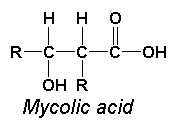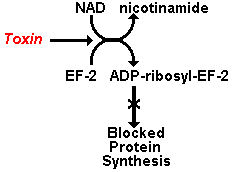|
Corynebacterium
ORGANISM:
- Genus: Corynebacterium
- Species: diphtheriae
GENERAL CONCEPTS:

- Corynebacteria belong in the family Mycobacteriaceae and are part of the CMN group (Corynebacteria, Mycobacteria and Nocardia).
- The family Mycobacteriaceae are Gram-positive, nonmotile, catalase-positive and have a rodlike to filamentous morphology (Corynebacteria are often pleomorphic).
- As a group, they produce characteristic long chain fatty acids termed mycolic acids. In the image to the right, the R-groups represent these chains. For Corynebacteria, chains of 28-40 carbons are common; for Nocardia, chains of 40-56 carbons are produced; for Mycobacteria, the chains are 60-90 carbons in length.
DISTINCTIVE PROPERTIES:
- Corynebacterial cell walls contain thin spots which leads to some Gram variability and "ballooning" that produces a "club-shaped" cell. Old cells store inorganic phosphate, which can appear as metachromatic granules when stained.
PATHOGENESIS:

- C. diphtheriae is the etiologic agent of diphtheria.
- These organisms colonize the mucus membranes of the respiratory tract and produce the enzyme neuraminidase which splits N-acetylneuraminic acid (NAN) from cell surfaces to produce pyruvate which acts as a growth stimulant.
- C. diphtheriae also produces diphthin, which is a protease that inactivates IgA.
- Toxigenic strains carry the gene tox, which resides on certain bacteriophages; lysogenization leads to toxigenicity.
- The toxin that is produced is a single polypeptide of 62,000 daltons and contains a single disulfide cross-link. Digestion with trypsin gives 2 fragments, A and B. The B (binding) fragment attaches to cell surfaces then proteases release the A (active) fragment to enter the cell. In the cell, the toxin acts as an ADP-ribosyltransferase, inactivating translation factor EF2.
HOST DEFENSES:
- Humoral immunity (antitoxin) is important in preventing disease.
EPIDEMIOLOGY:
- Diphtheria exists throughout the world and occasional outbreaks occur almost yearly.
- The Schick test can be used to ascertain population risk. This test involves the injection of a minute amount of the diphtheria toxin under the skin. The absence of a reaction indicates immunity.
DIAGNOSIS:
- Clinical: Muscle weakness, edema and a pseudomembranous material in the upper respiratory tract characterizes diphtheria.
- Laboratory: Tellurite media is the agar of choice for isolation of Corynebacteria, which produce jet black colonies.
CONTROL:
- Sanitary: Reduce carrier rate by use of vaccine.
- Immunological: A vaccine (DPT) prepared from an alkaline formaldehyde inactivated toxin (i.e. toxoid) is required. Passive immunization with antitoxin can be used for patients.
- Chemotherapeutic: Penicillin, erythromycin or gentamicin are drugs of choice.
|
|